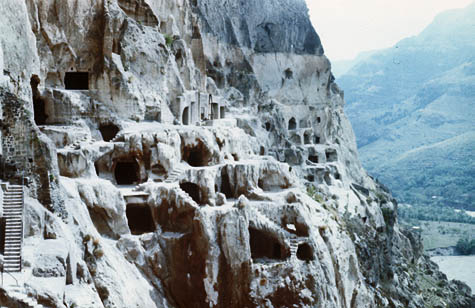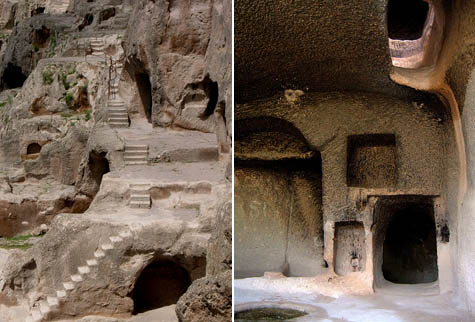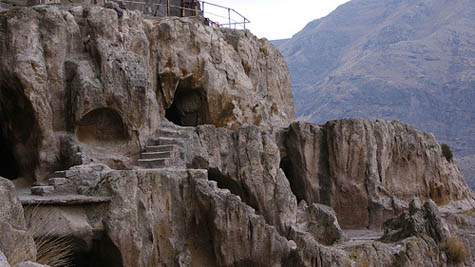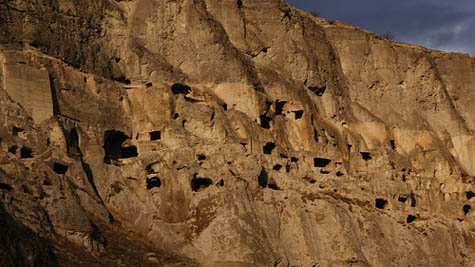 [Image: The Georgian cave monastery of Vardzia, via Wikipedia].
[Image: The Georgian cave monastery of Vardzia, via Wikipedia].
Vardzia is a ruined honeycomb of arched passageways and artificially enlarged caves on a steep mountainside in Georgia. It is on a “tentative list” for UNESCO World Heritage status.
 [Image: Vardzia, via Wikipedia].
[Image: Vardzia, via Wikipedia].
Quoting from Wikipedia:
The monastery was constructed as protection from the Mongols, and consisted of over six thousand apartments in a thirteen-story complex. The city included a church, a throne room, and a complex irrigation system watering terraced farmlands. The only access to the complex was through some well hidden tunnels near the Mtkvari river.
Nearby are the ruins of another cave monastery, called Vanis Kvabebi.
 [Images: Vardzia, via Wikipedia].
[Images: Vardzia, via Wikipedia].
In the formal application sent to UNESCO for consideration of the site, we read that the architecture of this region can be seen as spatially punctuating the landscape, supplying moments of almost grammatical emphasis:
Fortresses and churches erected on high mountains and hills are perceived as distinguished vertical accents in such a horizontally developed setting. They terminate and emphasise natural verticals, being in perfect harmony with the latter. They introduce great emotional impulse imparting specific grandeur to the whole environment. The same artistic affect is created by rock-cut monasteries and villages arranged in several tiers on high rocky mountain slopes.
Originally constructed in the 12th century—in a region inhabited by humans since at least neolithic times—and very much resembling one of the cave-cities of Cappadocia, Vardzia is a spatially fantastic site (and, I’d assume, a videogame level waiting to happen).
 [Images: Vardzia, via Wikipedia].
[Images: Vardzia, via Wikipedia].
It is also located in one of the most geologically interesting places on earth—at least from a subterranean standpoint—as the nation of Georgia also contains the world’s deepest known cave.
As National Geographic explained in an article several years ago, Krubera Cave—also known as Voronya—is still incompletely explored, despite its record-breaking, abyssal depths; expeditions have spent more than three weeks underground there, mapping windows and chambers, sleeping in tents, and using colored dyes to trace rivers and streams locked in the rock walls around them.
Check out this sequence of images, for instance, documenting an organized descent into the planet—or this article about caving in Abkhazia, or even this summary of the “Call of the Abyss” exploration project that sought to find the true depths of Voronya Cave.


 [Images: Vardzia, as seen in some stunning photos by cosh_to_jest].
[Images: Vardzia, as seen in some stunning photos by cosh_to_jest].
In any case, there’s absolutely no geological connection between Vardzia and Krubera Cave—there is no secret tunnel system linking the two across the vast Georgian landscape (after all, they are extremely far apart)—but how exciting would it be to discover that Vardzia had, in fact, been constructed as a kind of architectural filter above the stovepipe-like opening of a titanic cave system, and that, 800 years ago, monks alone in the mountains reading books about the end of the world might have sat there, surrounded by fading frescoes of saints and dragons, looking into the mouth of the abyss, perhaps even in their own local twist on millennial Christianity standing guard over something they believed to be hiding far below.
 [Images: Vardzia, via Wikipedia].
[Images: Vardzia, via Wikipedia].
In fact, I don’t mean to belabor the point here, but I’ve always been fascinated by the fact that the CIA has satellite photos that have been used as scouting documents for the rumored location of Noah’s Ark—it is “satellite archaeology,” one researcher claims. That is, there being quite a few religious members of the U.S. government, things like Noah’s Ark are considered more objective and archaeological than they are superstitious or theological.
But how absolutely mind-boggling would it be to find out someday that there is, operating within the U.S. intelligence services, a small group of especially religious analysts who have been scouring the Caucausus region, funded by tax dollars, and armed with geoscanning equipment and several miles of rope, looking for the entrance to Hell?
You can see further images of Vardzia here.